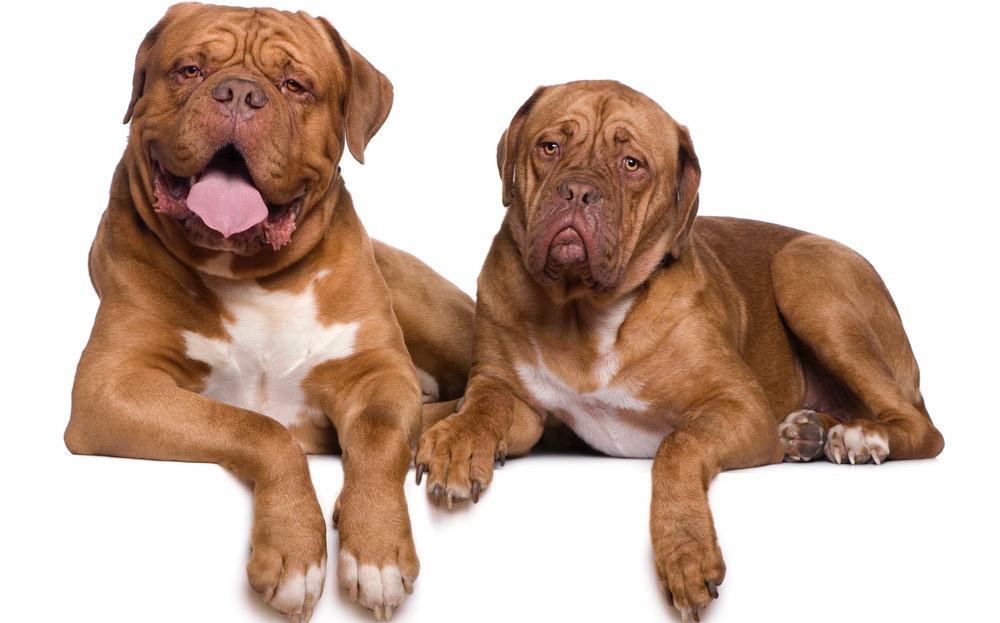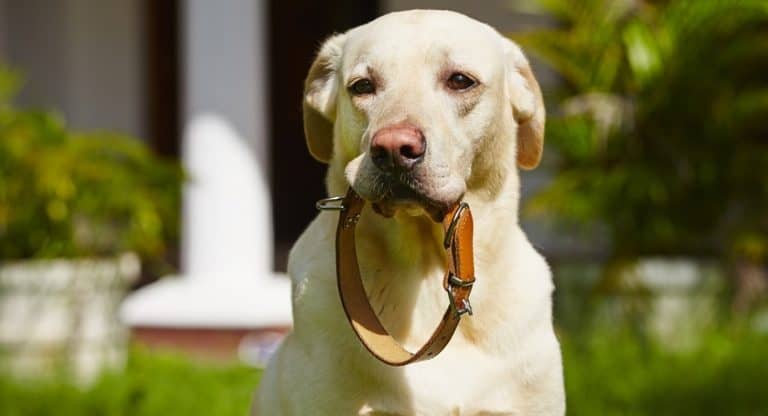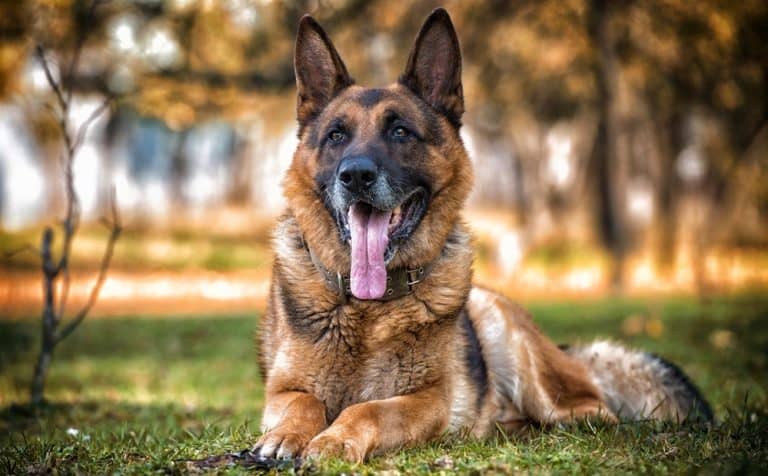Dogue De Bordeaux Growth Chart – French Mastiff Weight & Size Chart
The Dogue de Bordeaux also known as the French Mastiff, is the most ancient French dog breed.
If you are a current owner or thinking of owning this beautiful breed, then a Dogue de Bordeaux growth chart will be useful to you.
French Mastiffs are affectionate to their humans but also quite protective of them which makes them great guardians and a little aggressive to strangers. They are loved for their loyalty, courage, and beauty.
Dogue de Bordeaux’s are fawn coated and brawny. They have large heads, and they are close to the ground. Their heads are larger than most dog breeds.
However, don’t let their stocky physique fool you, they can move like a lion when the need arises.
When Is A Dogue De Bordeaux Fully Grown?

The answer to this question is not as easy as you may think because dogs have different growth rates which are determined by a myriad of factors.
Dogue de Bordeauxs are considered fully grown when they are approximately 19 months old. This age is the same for both males and females.
After they are fully grown, it does not mean that they will stop gaining weight.
You can expect your Dogue de Bordeaux to weigh about 120 to 140 lb when they are adults. Note that this is an average range since some dogs may weigh more or less than this depending on their lifestyle.
They usually attain a height of 23 to 27 inches. Even though males are slightly larger, there is little variation.
Even though Dogue de Bordeauxs are sturdy, they don’t need an endless amount of space the way other dogs do. They are an easy-going breed so as long as they are comfortable and able to move around freely they will be happy.
They are not as energetic as other breeds so outdoor space is not that important to them, but they still require physical activity in the form of a walk or playtime.
Furthermore, they should not be kept inside an apartment room all day.
Dogue De Bordeaux Weight Chart
The following chart shows the estimated representation of your Bordeaux weight. There may be instances where our estimations do not line up with your dog’s actual weight.
This is considered normal because there are quite a few factors that determine your dog’s ultimate weight.
Therefore, if you notice that your dog has a weight that is greater or lesser than what is presented on the Dogue de Bordeaux growth chart, you do not need to panic.
Remember these are weight estimations derived from averages of the breed. The best thing you can do is monitor your dog to make sure that he is in proper health.
That said, you may be dealing with a situation where your Bordeaux weighs considerably less than our Dogue de Bordeaux weight chart recommendations. In that case, you need to do a physical assessment of your Dogue de Bordeaux.
Start by looking at his waist from the aerial view. If his waist is deeply sunken in, then he may be undernourished. Dogs also have protruding ribs when they are underfed and underweight.
On the other hand, your dog could be overweight, and you will know us by running your hands along his rib cage. If you are unable to feel his ribs then you know he is overweight here.
To use this chart effectively, you simply need to have an accurate account of your dog’s age and match it with the ages on the left of the column of the chart. Then look for the coinciding weight listed.
Dogue de Bordeaux Puppy Weight Chart
| Age | Weight (kg) | Weight (lbs) |
|---|---|---|
| 3 Months | 20 kg | 44 lbs |
| 4 Months | 25 kg | 55 lbs |
| 5 Months | 30 kg | 66 lbs |
| 6 Months | 35 kg | 77 lbs |
| 7 Months | 40 kg | 88 lbs |
| 8 Months | 45 kg | 99 lbs |
| 9 Months | 48 kg | 105 lbs |
| 10 Months | 50 kg | 110 lbs |
| 11 Months | 52 kg | 114 lbs |
| 12 Months | 53 kg | 116 lbs |
| 14 Months | 54 kg | 119 lbs |
| 16 Months | 55 kg | 121 lbs |
| 18 Months | 56 kg | 123 lbs |
Dogue De Bordeaux Growth Chart – What To Expect

Birth – 2 Weeks
Bordeaux pups are born into litter sizes of about 5 to 8 puppies. They are in a sensitive stage and rely on their mothers to nourish and keep them warm.
This critical time with their mothers should be uninterrupted by human contact.
Expect that your Dogue de Bordeaux will be sleeping and nursing most of the time to gain strength so that he can continue his development.
His eyes will be closed, but they will soon open as he gets older. He does not have proper use of his muscles and limbs.
3 Weeks – 12 Weeks
This period will see many transitions in your Bordeaux’s physical development. One major shift in your dog’s introduction to solid foods.
Up until this point, your puppy may have been receiving nourishment primarily from the milk of its mother. But now he needs to be introduced to puppy chow or homemade food.
The food must be properly prepared to the right consistency so that it is palatable to your puppy.

Keep in mind that his teeth and gums will not be developed properly so his food needs to be soft and small enough to fit in his tiny mouth.
It also needs to be the correct temperature because food that is too hot may do serious damage.
At the end of this stage, a male French Mastiff usually weighs around 40 to 48 lb, and the females way around the same.
4 Months – 9 Months
Dogue de Bordeaux would most likely enter their heat cycle during this stage. They do this when they are about 6 months old.
The heat cycle does not last that long, but you should be on the lookout for strange behaviors especially around other dogs.
Keep your dog safe in a fenced area so that he is not tempted to run away. At six months old a Dogue de Bordeaux usually weighs between 73 and 85 lb.
10 Months – 18 Months
Your Bordeaux will be almost done growing at this point since they are considered fully grown at 19 months of age.
At the one-year mark, you can expect both males and females to be around 110 to 130 lb. They may continue to gain muscle and weigh a bit more after this stage.
Adult
This is the time when your Dogue de Bordeaux is considered a full adult.
Remember that as an adult, his portion sizes should be adjusted because he is not still in development and will require fewer calories. He would also require less protein as younger puppies tend to need more protein than adults.
How Big Do Dogue De Bordeaux Get?
To create proper accommodations for your Dogue de Bordeaux you may be wondering about their eventual size.
There is no exact calculation to determine your dog’s ultimate size, however, there are a few reliable options that you can choose from.
The very first one of them is to simply look at the growth charts within this article that can assist with predictions.
Apart from growth charts, genetics is the most reliable way to tell the ultimate size of a dog. If a dog’s parents are smaller in size then they tend to be as well. Usually, dogs are the average size of both parents.

Alternatively, you can examine your dog’s paws and estimate how much growth they have left in their development. This is because a dog’s paws and head are usually bigger in proportion to the rest of his body.
DNA tests are also an option because we can map the DNA of your dog so that you can know if there are any other breeds hidden within your dog’s genealogy.
Will Neutering/Spaying My Dogue De Bordeaux Affect His Growth?
Researchers and dog owners have different opinions about spaying or neutering their dogs. This is because there are some advantages and disadvantages to either option.
Spaying and neutering can prevent certain diseases in your dog, but it must be done at the right time because having them spayed or neutered too young, have detrimental effects.
For example, if you were to neuter a male dog when he is too young, he could end up too tall and also have joint problems.
It is better to wait until adulthood is reached, and the joints are in place before you spay or neuter your dog.
That said, there are many advantages, like eliminating the risk of unwanted pregnancies which may cause serious harm to your dog and cost you money as well.
Dogue De Bordeaux Size Chart
The task of measuring your Dogue de Bordeaux is not particularly hard, but you must understand what you are doing. You need a carpenter’s level, a pencil, and a measuring tape.

Get your Bordeaux to stand against a wall to take accurate measurements. He must be standing up straight without slouching.
Measure his height by the withers which is the highest point of his shoulder blades.
Then all you need to do is use the carpenters level and extend it across to the end of the wall and measure that exact spot down to the floor with the measuring tape. Take a record of this measurement for future use.
Bullmastiff Vs Dogue De Bordeaux Size
The Bullmastiff and French Mastiff are a breed with a few similar and distinct characteristics, including their common ancestry. But they also have many differences like their size and their coats.
The French Mastiff is a heavy and large dog that weighs over 68 kg for males and 57 kg for females. When it comes to height, the females stand at 57 to 65 cm while males stand at 60-69. French Mastiffs also have the largest hands of all the dog breeds.
On the other hand, the Bullmastiff has a coat that is short with a mix of colors including brown, red, brindle, or fawn.
They have a short black muzzle and the females usually weigh around 45 to 54 kg while the males when you 50-59 kg. They both usually stand at 63 to 69 cm in height.
Factors That Affect Dogue De Bordeaux Growth
Genetics & Gender
For Dogue de Bordeauxs, genetics usually play a major role in their growth and size because their physical characteristics are inherited from their parents passed down through generations.
If your Bordeaux puppy has two parents that are larger than normal then he will probably be larger than normal as well. Gender comes into play with the size of your Bordeaux since males are slightly larger than females.
Nutrition
The Dogue de Bordeaux should be fed dog food of high quality but should also be appropriate to age. Remember that as dogs are developing they require more calories and more protein.
This is why you should give them dog food that has animal protein as the first ingredient. Avoid giving your dog table scraps as they may affect his health.
Stick to a schedule of feeding that is comfortable for your dog and only feed him at those times.

Keep in mind that the Bordeauxs usually have grain allergies so be careful of the dog food you decide to give them. If you notice they are gaining excess weight you should reduce their calories.
Physical Activity & Health
When your Bordeaux is very young, you should avoid strain to the joints by engaging him in low-impact exercise only.
When he is at least 18 months old then you can try something different. Do not overexert your Bordeaux. Stick to flat surfaces as opposed to hills or steps.
When your Bordeaux is older, he can engage in more vigorous exercise, but that does not mean that he should be over-exerted.
Remember that this breed is also prone to obesity, so make sure that he gets at least 30 minutes of light exercise per day. But keep in mind that too much exercise can cause joint injury.
What If My Dogue De Bordeaux Is Not The Right Weight
A Bordeaux usually weighs 57 to 68 kilograms in adulthood, but this is dependent on a variety of factors. To find out if your Bordeaux is too thin you should observe him.
By observing your dog, you can find out a lot of what you need to know from their physical features.
Do a profile check so that you can gain information about their weight. By looking at a dog’s profile and his waist, in particular, you can learn if he is overweight or underweight.
If his waist (right before his hind legs) is sunken in then he is probably underweight.
You can also run your hands along the rib cage and if you cannot feel the rib cage, then you know that he is overweight.
Underweight dogs have rib cages that can be easily felt. But in the case of a Bordeaux, you can see a protruding rib cage because their fur is not long.
Dogue De Bordeaux Genetics And Common Health Problems
Bordeauxs have conditions like gastric dilation, bloat, and volvulus, so you should have the necessary knowledge on these diseases so that you can prolong your Bordeaux’s life.
Look for the signs and symptoms of these diseases so that you can practice early intervention and treatments.
Bordeauxs also suffer from cancer, heart disease, epilepsy, and orthopedic conditions like elbow and hip dysplasia.
Only purchase your Bordeaux from a responsible breeder who will screen for these conditions and let you know if the puppies have a clean bill of health.
Final Words
Bordeaux’s are well known for their drooling and their wrinkles. This is why they require special attention and weekly grooming to keep dry and clean.
Make sure to clean their ears weekly and brush their teeth as well. You should trim their nails every month and involve them in obedience training from an early age. Discipline is quite important to a Bordeaux.






